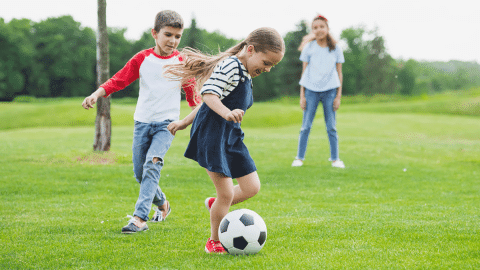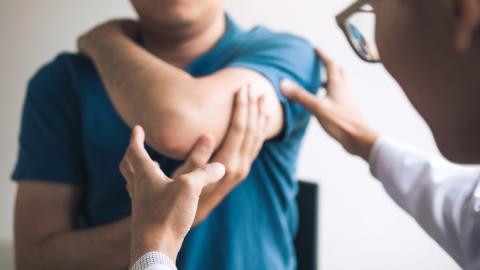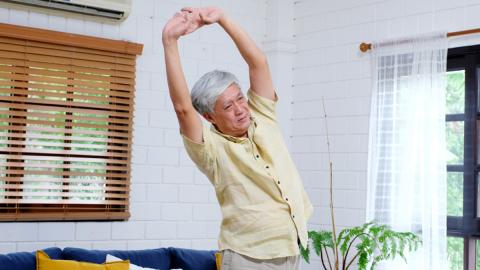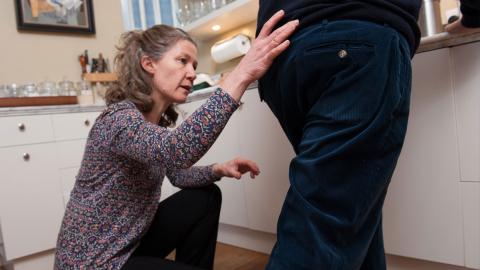Parents and carers of young children will often seek medical advice regarding the skeletal development of their child.
Children’s bones often develop in a way that can cause concern but is actually entirely normal. The following conditions are commonly seen in general practice. The information is designed to be a guide for parents/carers regarding when to seek medical advice.
On this page:
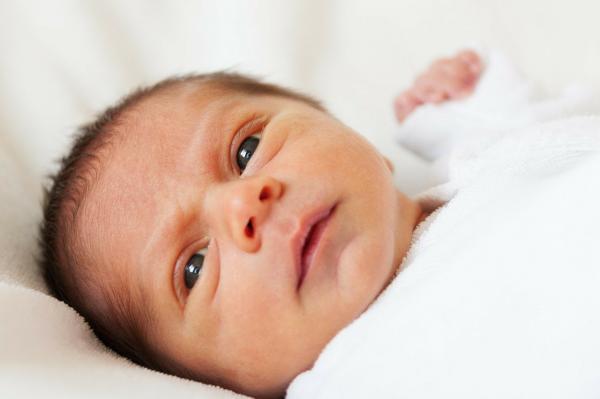
Head and neck issues
Head turn preference and plagiocephaly
Head turn preference occurs when a baby prefers to position their head to one side only.
Plagiocephaly is also known as flat head syndrome and can develop in babies if they spend a lot of time lying on their backs.
Resources
Vitamin D deficiency
Babies need vitamin D in order to grow and develop healthily. It helps them develop stronger teeth and bones. If they don't get enough vitamin D then they could develop rickets, which causes bones to become soft and weak.
Useful resources:

Hip issues
Hip dysplasia is when thejoint of the hip does not properly form in babies and young children. If left untreated it may lead to problems in later life.
Useful resources
Foot issues
Flat Feet

Children under six do not have an arch when they are standing. This is normal for most children.
Babies have fat under the skin in their feet and they have very flexible joints. This means that when they are standing up, it is difficult to see an arch.
The arch will usually appear when children are not weight bearing (for example when sitting on a seat with legs off the ground), or when they go up onto their tip toes. When they reach the age of six the arch may start to be visible.
However, some people never get an arch and most adults with flat feet do not have significant problems .
Seek advice if:
- Your child complains of pain in his/her feet
- Only one foot has an arch.
Useful resources
Club foot
Club foot (also called talipes) is a birth defect that can affect one or both feet. Early treatment usually helps correct it.
Useful resources
Toe walking
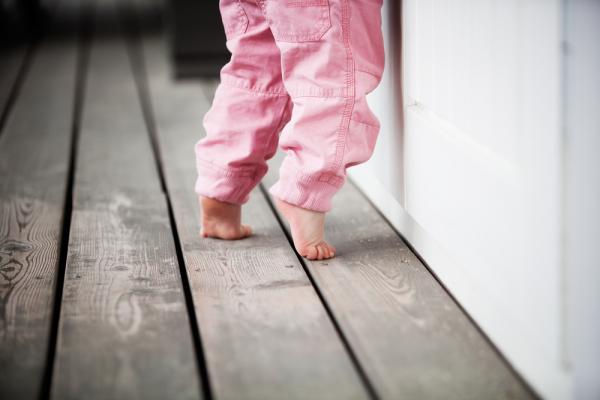
It’s common for children under the age of 3 to walk on tip toes from time to time As they get older, children usually start to get their heels down.
Seek advice if
- Your child is unable to stand still with their heels on the ground
- They are limping without an obvious cause
- They only toe walk on one leg/foot
- Your child complains of pain.
- If it has not improved by the age of five.
In-toeing when walking
Toddlers often walk with their toes running inwards but they usually grow out of it once they become stronger and have mastered the art of walking. There are several reasons for the in-toeing:-
- Feet that are slightly bean shaped – usually seen just after birth and will usually get better on its own but may require some simple stretches.
- A twist in the shin bone (see knock knees) – usually better by the time they are eight
- A twist in the thigh bone – once again common in children and will usually correct itself by the age of ten or 11.
Seek advice if
- They in-toe only on one leg
- It has not improved by the age of 10
- They complain or pain or they trip so often it affects daily life (note, tripping is common in pre school children but if they trip more than 2- 3 times a day please ask for advice).
- There is no improvement in foot shape after the age of five.
Useful resources
- In-toeing (metatarsus adductus)
- Choosing footwear for children
- Metatarsus adductus
Leg issues

Bowed legs
Children under 5 years of age go through periods of development when their legs appear to be bowed or knock kneed. It's normal for babies and toddlers to have bows in their shin bones. When the legs are placed together with knees facing up towards the sky/ceiling you may see a gap between their knees. This is entirely normal and will usually resolve once they are two or three years old.
Seek advice if
- the gap between their knees is more than 10 cm apart
- one leg looks more bowed than the other.
Knock knees
It is common for children between the age of 3 and 5 to have knock knees – this can be seen when the child is either standing or lying down with their knees together. A gap can be seen between the ankle bones. This is normal and should improve gradually over 2 or 3 years.
Seek advice if:
- The gap between the ankles is more than 10cm
- There is a limp
- One leg looks a different shape to the other
- The child is short for their age
- There are complaints of pain
- The appearance has not improved by the age of seven or eight.
Useful resources
Limping
If your child is limping, it's usually the sign of a minor injury such as a sprain or splinter.
But see your GP if there's no obvious cause, as there may be a more serious underlying medical condition.
Persistent pain
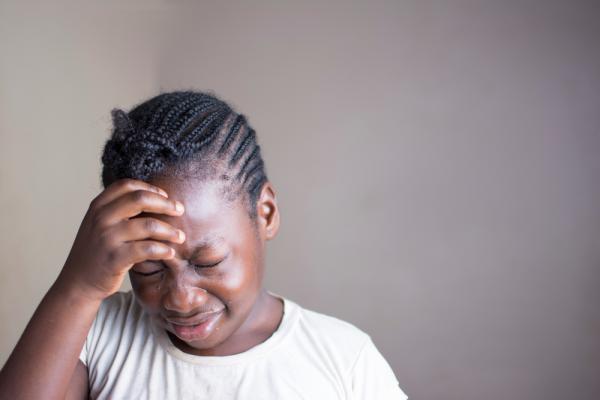
Pain can be described as acute, where it is of recent onset, or chronic / persistent, which is commonly defined as longer than three months. However, in reality there is often no clear dividing line between acute and chronic pain.
Acute pain often is associated with a specific injury or occurrence. However, any pain can come on gradually without a known or recognisable reason. It can also be intermittent (coming and going e.g. headaches or tummy pain.)
The long-term effects of chronic pain on sensory nerve processing are not well understood, but it is likely that changes occur leading to excess sensitivity and altered signalling in the nervous system, without any ongoing tissue damage or injury.
Most persistent / ongoing pain in children can be effectively managed in primary care by a GP or physiotherapist or AHP, with appropriate investigations to exclude treatable causes. (See other sections on specific areas of pain.) These resources are intended to help those with ongoing pain in which a serious underlying cause has been excluded.
There are certain types of pain which indicate the need for urgent medical attention – these are:
- nerve pain (descriptions of burning, shooting / stabbing pain) or pain associated with colour and/or temperature change in the area of the body, increased sweating, alterations in nail or skin.
- Concerns about a child’s ability to keep themselves safe from harm
- Pain resulting in mood disturbance
- Pain resulting in ongoing loss of school attendance
- New pain in a child with a known life-limiting diagnosis
- Most pain results in a reluctance to move that area but where a child is unable to activate the muscles to move the area.
There is a significant minority of children where chronic pain can be severely debilitating, affecting all aspects of the child’s life and that of their parents and family members. The impact of pain is wide-ranging affecting school attendance, participation in sports or social activities as well as increased healthcare seeking and medication use. These young people are best managed as part of a multi-disciplinary pain service.
Useful resources
Arthritis
There are many types of arthritis, including osteoarthritis (OA) and rheumatoid arthritis (RA). These cause pain, heat and stiffness in your joints and can affect people of all ages.
In children it's known as juvenile arthritis and can cause pain and inflammation in the joints for at least six weeks at a time.
Useful resources
When to seek medical advice
Babies and infants
Please seek medical advice if your baby:
- Keeps their head turned to one direction when awake and/ or asleep
- Develops a flattened area on their head
- Has a lump/ swelling on one side of his/ her neck
- Is moving one limb less than the others
- Keeps their thumbs tucked into his/ her palms
- Has a leg length difference
- Feet have a fixed position or limited movement
- Is not meeting their developmental milestones as expected
You should also seek advice if you have any of the following concerns regarding your child’s development:
- Age two: Not able to walk independently Not able to walk up and down stairs holding on
- Age three: Not able to walk up and down stairs independently Not able to run or jump
- Age four: Not able to walk, run, climb, jump and use stairs confidently. Not able to catch, throw or kick a ball
Pre-primary and primary aged children
Seek urgent medical advice if your child has one or more of the following symptoms:-
- Limps without an obvious cause
- Has a fever that lasts longer than 48 hours
- Has a rash that does not fade when a glass is pressed against it
- Has pain in just one limb or joint (non symmetrical symptoms)
- Wakes repeatedly in the middle of the night complaining of pain in one area of the body (not usually two or more limbs)
- Loss of skills, for example; finds it difficult to get up from the floor but in the past could do so.
- Has a hot, swollen joint or acute pain not associated with an injury
- Symptoms worsen or do not settle after 48 hours.
- Toe-walking on one leg.
- A loss of sensation/numbness
- Is unable to weight bear
- Complains of back pain that persists for more than 48 hours.
- Night pain that isn't relieved by painkiller such as Calpol or Nurofen
Secondary school aged children and teenagers
Seek advice if your child/young person complains of any of the following symptoms:
- Persistent night pain (not responsive to simple analgesia)
- General malaise/ lethargy
- Persistent fever
- Weight loss/ reduced appetite
- Acute joint pain with no associated injury
- Joint tenderness
- Joint swelling with no associated injury
- Behavioural changes (poor sleep/ irritability)
- Coca-cola coloured urine
